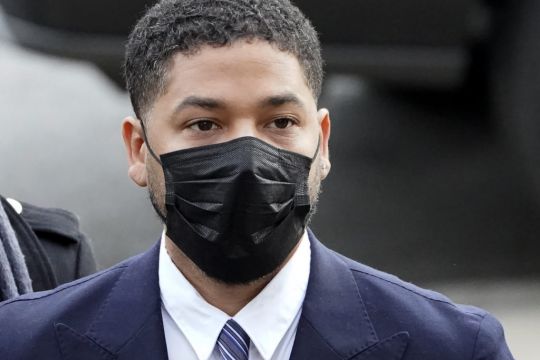Jussie Smollett, who is accused of lying to police when he reported he was the victim of a racist and homophobic attack in Chicago, appeared troubled when he was told that a surveillance camera did not record the alleged assault, a police detective testified on Wednesday.
Chicago police detective Kimberly Murray described how she took a report from the former Empire actor the morning of the January 2019 attack at Northwestern Memorial Hospital, where he was being treated for injuries that Ms Murray described as “minor”.
Smollett said two men — one white and wearing a ski mask, the other he could not see — assaulted him as he was returning home after buying a sandwich.
Ms Murray said Smollett — who said he had received a threatening phone call days earlier — refused to hand over his mobile phone, which the detective said could help police piece together a timeline of what happened, and he would not consent to giving medical records or a DNA swab.
She also said Smollett was “upset” when she told him a surveillance camera in the area did not capture the alleged attack because it was pointed away from the scene.
Ms Murray said she explained to the actor that the cover on the pod camera makes it impossible to know which way it is pointing.

A lead investigator in the case, Michael Theis, said on Tuesday that two brothers who worked with Smollett on the Chicago set of Empire later detailed for police how the actor orchestrated the hoax and they participated in it.
They said Smollett told them via text message to meet him “on the low”, paid for supplies including a clothesline later fashioned into a noose, and took them for a “dry run” in downtown Chicago prior to the alleged attack.
Mr Theis, who is now assistant director for research and development for the Chicago Police Department, said roughly two dozen detectives clocked some 3,000 hours on the investigation, rebutting a defence lawyer’s statement that they rushed to judgment.
He said police were excited when they were able to track the movements of two suspected attackers using surveillance video, mobile phone records and reports from ride-sharing services.
“The crime was a hate crime, a horrible hate crime,” Mr Theis said, noting Smollett reported that his attackers put a noose around his neck and poured bleach on him.
Defence lawyer Nenye Uche has said the brothers attacked Smollett because they did not like him “because of who he is”, and suggested on Tuesday that the brothers were homophobic.
Smollett is charged with six counts of felony disorderly conduct for making what prosecutors say was a false police report — one count for each time he gave a report, to three different officers.
The class 4 felony carries a prison sentence of up to three years, but experts have said if Smollett is convicted he likely would be placed on probation and perhaps ordered to perform community service.

Police arrested brothers Abimbola and Olabingo Osundairo who, when questioned, said Smollett asked them to stage the attack because he was unhappy about how the TV studio handled hate mail he had received, Mr Theis said.
He said investigators checked out the brothers’ account — including that the actor picked them up days before the attack and drove them around the neighbourhood where he lived and talked about what would happen — and corroborated their version of events using GPS, mobile phone records and video evidence. Police found no instance where they concluded the men were lying, he said.
“At the end of the investigation, we determined that the alleged hate crime was actually a staged event,” Mr Theis said. The Osundairo brothers were released.
Jurors were shown surveillance video of the brothers buying supplies, including a red hat they told police Smollett wanted them to wear to resemble supporters of then-President Donald Trump, and a piece of clothesline police said was later fashioned into the noose.
Jurors also saw a still image from a video that Mr Theis said showed Smollett returning home the night of the alleged attack, with the clothesline draped around his shoulders. The clothesline was wrapped around his neck when officers arrived, Mr Theis said, leading detectives to believe Smollett may have retied it.
Mr Uche has portrayed the Osundairo brothers as unreliable, and said when police searched their home they found heroin and guns. The brothers will testify at trial, but it is unknown if Smollett will.
Mr Uche asked Mr Theis on cross-examination about a homophobic word one of the brothers used.
Mr Theis said there was a message containing a slur but that he does not know if that makes the man homophobic.
Mr Uche also asked Mr Theis if he was aware one of the brothers attacked someone at the TV studio where Empire was filmed because he was gay.
“One individual said it happened, but I don’t know that it happened,” Mr Theis said.
Mr Uche also sought to discredit the police investigation, suggesting detectives ignored possible leads. And he said a 3,500 dollar cheque the actor paid the brothers was for personal training so he could prepare for an upcoming music video, not for carrying out the hoax, as prosecutors allege.
Mr Theis said the memo on the cheque said it was for “nutrition” and “training”.
Mr Uche also has suggested that a third attacker was involved. One area resident said she saw a white man with “reddish brown hair” who appeared to be waiting for someone that night, according to police reports.
She told a detective that when the man turned away from her, she “could see hanging out from underneath his jacket what appeared to be a rope”.
Under cross-examination, Mr Theis acknowledged that he saw that statement but did not send a detective to re-interview the woman. He said she had seen the man a few hours before the alleged attack and that “the rope was a different colour”.







